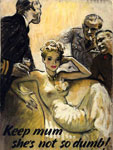At a Glance
Topics
Features
Duration
Grade(s)
Lesson Format
Download
Propaganda and World War II
Students compare World War II propaganda posters from several countries and then choose one of several writing assignments to demonstrate what they’ve learned.
Review

In this lesson from HERB—a website produced by the American Social History Project/Center for Media and Learning—students learn how to examine posters as primary sources and work with them to write essays. In addition to a collection of wartime propaganda posters, the site includes a brief essay providing historical context, as well as a well-designed “propaganda poster analysis worksheet” that students can use to explore the meaning of each document.
After work in small groups that includes each student analyzing a poster, students demonstrate their understanding through different kinds of writing assignments. These range from considering the historical time and events the poster sits within, to comparing two posters, to fiction writing.
The strength of this lesson is the collection of documents it brings together. Posters from the United States, Great Britain, Nazi Germany, and the Soviet Union give students insight into the propaganda machines operating in each country during the Second World War. Because each document is visual in nature, it is a good lesson for struggling readers and English Language Learners. The group structure is also a strength as students have the opportunity to analyze a single poster, but also to look for patterns across several posters.
The HERB website can be navigated several different ways: by collection, by historical era, or by approximately 70 different teaching activities.
Notes
| Field | Criteria | Comments | ||
|---|---|---|---|---|
| Historical Content | Is historically accurate? | Yes |
||
| Includes historical background? | Yes |
|||
| Requires students to read and write? | Yes |
|||
| Analytic Thinking | Requires students to analyze or construct interpretations using evidence? | Yes |
||
| Requires close reading and attention to source information? | Yes |
|||
| Scaffolding | Is appropriate for stated audience? | Yes |
||
| Includes materials and strategies for scaffolding and supporting student thinking? | Yes |
|||
| Lesson Structure | Includes assessment criteria and strategies that focus on historical understanding? | This is partly dependent upon the choice of writing assignment. No criteria are included. |
||
| Defines clear learning goals and progresses logically? | Yes |
|||
| Includes clear directions and is realistic in normal classroom settings? | Yes |
|||